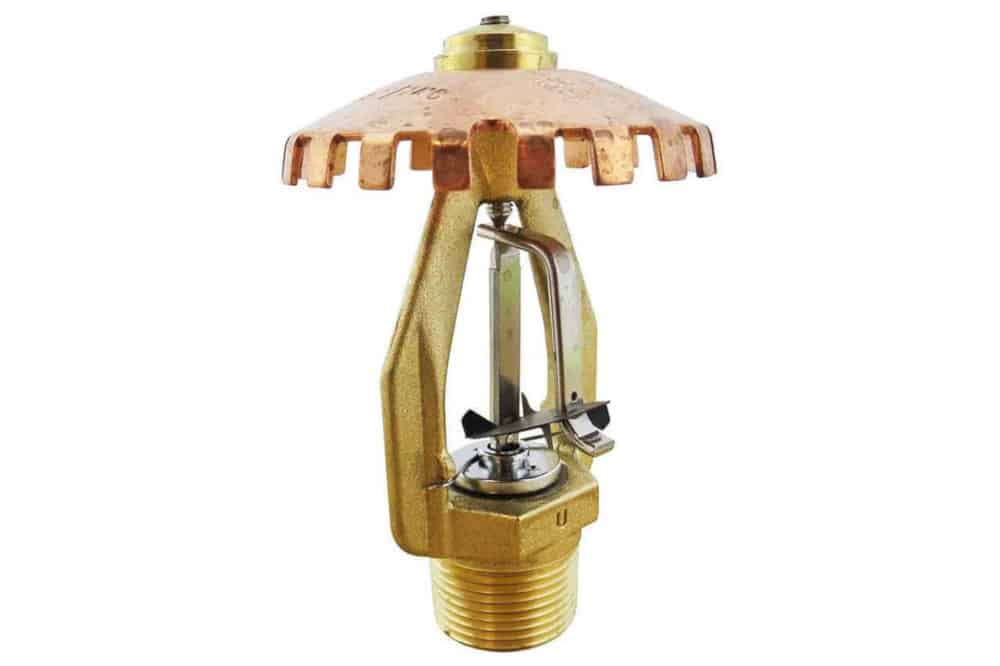An ESFR sprinkler system, or Early Suppression Fast Response sprinkler system, is specifically designed for high-challenge fire hazards. It delivers water quickly to suppress fires before they escalate, making it a crucial tool in fire protection.
Especially effective for warehouses and storage facilities, ESFR sprinkler systems are recognized for their ability to rapidly control fires in challenging environments.
These systems use larger orifice sprinklers with higher water flow rates to provide quick and efficient fire suppression. By combining fast response times with high water discharge rates, ESFR sprinklers ensure the safety of both occupants and property.
Understanding the importance and functionality of ESFR sprinkler systems is essential for effective fire protection measures in commercial and industrial settings.
Contents
- Understanding Fire Protection Systems
- Esfr Sprinkler System: An Overview
- How Does An Esfr Sprinkler System Work?
- Maximizing Fire Protection With Esfr Sprinklers
- Design Considerations For Esfr Sprinkler Systems
- Installation And Maintenance Of Esfr Sprinklers
- Frequently Asked Questions On What Is An Esfr Sprinkler System
- Conclusion
Understanding Fire Protection Systems
In order to ensure the safety of people and property, fire protection systems play a crucial role. Understanding different types of fire protection systems and their importance is essential for preventing and mitigating fire risks.
Effective fire protection measures are paramount for any building or establishment, and one such system that contributes to efficient fire suppression is an ESFR sprinkler system.
Types Of Fire Protection Systems
Fire protection systems are designed to detect and suppress fires, preventing them from spreading and causing significant damage.
Here are some commonly used types of fire protection systems:
- Fire Sprinkler Systems: These systems are the most widely used and effective means of fire suppression. They consist of a network of pipes with sprinkler heads that release water or other extinguishing agents when heat is detected.
- Fire Alarm Systems: Fire alarm systems include smoke detectors, heat detectors, and manual pull stations that signal the presence of a fire. They alert building occupants and initiate necessary actions, such as evacuation or fire department notification.
- Fire Extinguishers: Portable fire extinguishers are essential for initial firefighting efforts in small-scale fires. These devices typically contain chemicals or agents that can extinguish flames by disrupting the fire triangle.
- Fire Suppression Systems: These systems use special agents to suppress fires, such as clean agents, foam, or gas-based systems. They are commonly employed in high-value areas or where water-based systems are not suitable.
- Emergency Lighting Systems: Emergency lighting systems provide illumination in the event of a power failure during a fire incident. They assist building occupants in finding exits and navigating safely.
Importance Of Effective Fire Protection
Effective fire protection systems are crucial for several reasons:
- Life Safety: Fire protection systems help safeguard the lives of occupants by providing early detection, warning, and suppression capabilities. They offer valuable time for evacuation and reduce the risks of injuries or fatalities.
- Property Protection: Fire can cause extensive damage to buildings, equipment, and inventory. Implementing effective fire protection measures minimize property loss, mitigating the financial impact of fire incidents.
- Business Continuity: A well-designed fire protection system enhances business continuity by reducing the downtime caused by fire-related disruptions. The ability to control and suppress fires promptly helps minimize operational interruptions.
- Legal Compliance: Building codes and regulations often require the installation of adequate fire protection systems. Complying with these standards ensures legal obligations are met, avoiding potential penalties or liability issues.
- Insurance Requirements: Insurance providers typically mandate specific fire protection measures as a condition for coverage. Implementing and maintaining effective fire protection systems ensures compliance with insurance requirements and maintains favorable coverage terms.

Esfr Sprinkler System: An Overview
What is an ESFR Sprinkler System?
An ESFR (Early Suppression, Fast Response) sprinkler system is a high-performance fire protection system designed to quickly suppress fires in warehouses, distribution centers, and other industrial facilities.
- Fire Sprinklers
- Water Supply System
- Piping Network
- Control Valves
- Fire Alarm System
How Does An Esfr Sprinkler System Work?
Operation Of An Esfr Sprinkler System
An ESFR sprinkler system works by quickly detecting and suppressing fires in high-hazard areas using specially designed sprinkler heads. These sprinkler heads release a large volume of water at high pressure to control and extinguish fires efficiently.
Advantages Of Esfr Sprinkler Systems
ESFR sprinkler systems offer fast response times, high flow rates, and effective fire suppression, making them ideal for protecting warehouses, manufacturing facilities, and other high-ceiling structures. These systems can help minimize property damage and protect lives in case of a fire.
Maximizing Fire Protection With Esfr Sprinklers
When it comes to fire protection, businesses need reliable solutions that can swiftly and effectively suppress fires, minimizing damage and ensuring the safety of occupants.
That’s where ESFR (Early Suppression Fast Response) sprinkler systems come into play.
These innovative sprinkler systems are specifically designed to provide maximum fire protection, making them an ideal choice for a wide range of applications.
Benefits Of Esfr Sprinkler Systems
- Effective Fire Suppression: ESFR sprinklers deliver a strong, concentrated water spray directly onto the fire source, rapidly extinguishing fires and preventing their spread. Their specialized design allows for quick response and increased fire suppression capabilities compared to traditional sprinklers.
- Reduced Water Damage: By providing swift and efficient fire suppression, ESFR sprinklers minimize the need for extensive water application. This helps in reducing potential water damage to the property, equipment, and inventory.
- Maximized Storage Capacity: ESFR sprinklers are specifically designed to protect high-piled storage, allowing businesses to utilize their storage space more efficiently. These sprinklers can be installed at higher elevations and still effectively suppress fires, maximizing storage capacity.
- Code Compliance: ESFR sprinkler systems are designed to meet or exceed specific fire code requirements, ensuring businesses stay compliant with safety regulations. Investing in ESFR sprinklers can help avoid penalties and keep insurance premiums under control.
Suitable Applications For Esfr Sprinklers
ESFR sprinklers are well-suited for various commercial and industrial applications where fire protection is crucial.
Some notable examples include:
- Warehouses: ESFR sprinkler systems are highly effective in large warehouses with high storage racks, protecting the products and minimizing the risk of fire spread.
- Manufacturing Facilities: Industries with manufacturing processes involving flammable materials and heat-intensive operations can greatly benefit from ESFR sprinklers to mitigate fire hazards.
- Distribution Centers: With the constant movement of goods in and out, distribution centers can significantly minimize fire-related risks by installing ESFR sprinklers.
- Cold Storage Facilities: ESFR sprinklers are designed to handle the unique challenges of cold storage facilities, where lower temperatures can impact the efficiency of traditional sprinkler systems.
Overall, ESFR sprinkler systems offer businesses a reliable and efficient solution to maximize fire protection. From effective fire suppression capabilities to reduced water damage and increased storage capacity, these sprinkler systems play a crucial role in safeguarding properties and ensuring the safety of occupants in various commercial and industrial settings.
Design Considerations For Esfr Sprinkler Systems
An ESFR (Early Suppression, Fast Response) sprinkler system is a type of fire protection system designed to quickly suppress and control high-challenge fires.
It is specifically suitable for warehouses and high-piled storage facilities. Designing an ESFR sprinkler system involves several key considerations to ensure its effectiveness and reliability.
Building And Occupancy Factors
When designing an ESFR sprinkler system, factors such as building height, storage configuration, and occupancy classification must be carefully evaluated.
The system’s design should account for the building’s structure, including ceiling height and clearance, to ensure efficient water distribution and coverage throughout the storage area.
Water Supply Requirements
The water supply plays a critical role in the performance of an ESFR system. Adequate water pressure and flow rates must be available to support the system’s operation in the event of a fire.
Additionally, the water source, whether it be from a municipal supply or an on-site water storage tank, should be capable of meeting the demands of the ESFR sprinkler design.
Installation And Maintenance Of Esfr Sprinklers
An ESFR (Early Suppression Fast Response) sprinkler system is a type of fire sprinkler design commonly used in high-piled storage and warehouse facilities.
This system is specifically designed to provide rapid and effective fire suppression in challenging environments.
Understanding the installation and maintenance requirements of ESFR sprinklers is crucial to ensure the system’s proper functioning and compliance with safety standards.
Installation Guidelines And Requirements
Proper installation of ESFR sprinkler systems is essential to guarantee their optimal performance in the event of a fire. The following guidelines and requirements should be adhered to during the installation process:
Ensure proper clearances: Maintain the required clearance between the sprinkler deflector and the stored materials, as specified by the manufacturer.
Use approved components: Install ESFR sprinklers using approved components and follow the recommendations provided by the system manufacturer to ensure compatibility and effectiveness.
Comply with regulations: Adhere to applicable building codes and regulations regarding the installation of ESFR sprinkler systems to meet safety standards and requirements. “`html
Periodic Inspections And Testing
Regular inspections and testing are essential for maintaining the functionality of ESFR sprinkler systems and ensuring their readiness to respond to a fire incident. Key aspects of periodic inspections and testing include:
Visual inspections: Conduct routine visual inspections to check for physical damages, obstructions, or any signs of corrosion or deterioration.
Functional testing: Perform regular functional testing of ESFR sprinklers to verify their operational readiness and ensure prompt activation in case of a fire.
Documentation: Maintain detailed records of all inspections and tests conducted, including any maintenance or corrective actions taken, to demonstrate compliance with regulatory requirements.
Maintaining ESFR sprinkler systems in accordance with installation and maintenance guidelines is integral to safeguarding properties and personnel against the destructive impact of fire incidents.

Frequently Asked Questions On What Is An Esfr Sprinkler System
What Is The Difference Between Esfr And Normal Sprinkler?
ESFR (Early Suppression Fast Response) sprinklers are designed to quickly extinguish fires by releasing a high volume of water.
Normal sprinklers, on the other hand, release a smaller amount of water to control fires.
ESFR sprinklers are suitable for high-risk areas like warehouses and offer better fire suppression capabilities than normal sprinklers.
How Does Esfr Sprinkler Work?
Esfr sprinkler works by quickly detecting a fire and releasing a large amount of water to suppress it.
It uses high-pressure water to distribute finely atomized droplets that cool the fire and create a barrier that prevents its spread. This helps protect both property and lives.
Are Esfr Sprinklers Wet Or Dry?
ESFR sprinklers are wet-type sprinklers that discharge water directly onto a fire to extinguish it efficiently.
What Are The Requirements For Esfr?
ESFR (Early Suppression Fast Response) requires high ceilings, smooth ceilings, and sprinklers with a K-factor rating of 16. 8 or higher.
The system also needs a specific design density and a maximum storage height. Regular maintenance is vital for optimal performance.
Conclusion
Esfr sprinkler systems offer efficient fire protection for high-hazard industrial environments. Understanding their benefits is crucial for safety and code compliance.
Implementing this technology can safeguard your property and personnel. Stay informed and consult with experts for optimal fire protection solutions.

